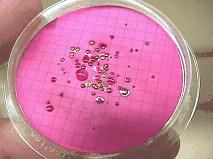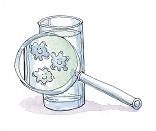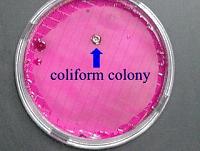| |

Is my water safe to drink? | Drinking water testing | Drinking and household suitability | Who is responsible for drinking water safety?
Is my water safe to drink?
If you do not monitor your water quality by having it tested at an accredited laboratory, you cannot tell whether your drinking water is safe or not.
Harmful bacteria, parasites, and viruses are invisible to the naked eye, so water that looks and tastes good may not necessarily be safe to drink. These microbes can exist in both ground and surface water supplies, and can cause immediate health effects if not properly treated for.

People often think that if they have not been sick for a while that there are no concerns with their water quality. Certain chemical contaminants that are sometimes found in a water source can cause long term health problems that may take years to develop. This stresses the importance of having an effective treatment system in place to ensure that your water is being treated to a satisfactory level.
What tests should I have done on my drinking water and how often?
There are many useful tests available to help determine the health, safety and performance of your water supply depending upon its type and location. Your local health department can assist you in selecting tests important for assessing your drinking water.
A number of commercial laboratories carry different water quality packages that include a variety of tests to assess water potability.
Basic drinking and household use suitability
Basic Water Potability Test packages include tests for:
- Coliform Bacteria
- Nitrate
- pH
- Sodium
- Chloride
- Fluoride
- Sulphate
- Iron
- Manganese
- Total Dissolved Solids
- Hardness
Coliform bacteria tests are used as an indicator test for the presence of microorganisms in the water that are potentially harmful to human health. Nitrate is a common contaminant found mainly in groundwater. High nitrate concentrations can be particularly dangerous for babies under six months, since it can interfere with ability of blood to carry oxygen. Ions such as sodium, chloride, sulphate, iron and manganese can impart objectionable taste or odor to water. Excessive amounts of sulfate can cause a laxative effect or gastrointestinal irritation, along with a noticeable taste. Excessive amounts of fluoride can cause dental problems. Total dissolved solids represent the amount of inorganic substances (e.g. iron, salts) that are dissolved in the water. High total dissolved solids (TDS) can reduce the palatability of water or cause health problems if specific constituent elements are at high levels.
Other tests may be appropriate if there is a particular reason to suspect that a specific contaminant may be present or if additional background information is desired. Groundwater sources are sometimes tested for parameters such as arsenic, selenium and uranium. Both surface and groundwater sources are also sometimes tested for pesticide contamination.
Private drinking water supplies should undergo basic testing annually at a minimum. Drinking water supplies obtained from shallow wells and surface water sources should be tested more frequently, such as seasonally as they are highly susceptible to contamination.
If you have critical water treatment equipment it is important to test both your drinking water at the tap and your source water. The testing of both will help you interpret if your treatment system is performing correctly or whether the quality of your source water has changed.
The following is a list of additional potential tests that are sometimes tested for, depending on the detail of information required.
| Bicarbonate | Calcium | Carbonate | Tannin and lignin |
| Hydroxide | Magnesium | cyanide | orthophosphate |
| bromate | Conductivity | Sulfide –as hydrogen sulfide | radon |
| Boron | Total Alkalinity | Chloride | trihalomethanes |
| Turbidity | Ammonia, as nitrogen | Potassium | Sulfate reducing bacteria |
| Aluminum | Arsenic | Barium | Heterotrophic Plate Count |
| Cadmium | Chromium | Copper | E. Coli |
| Dissolved organic carbon | Lead | Selenium | cyanobacteria |
| Zinc | Uranium | Total phosphorous | Faecal Coliform |
| True Colour | pesticides | Dissolved oxygen within 2 minutes of collection | Iron bacteria |
Here are some examples of water tests in Alberta and Saskatchewan:
Microbiological Indicators
Laboratory results may provide information on levels of Total Coliforms, Escherichia coli (E-Coli), and Heterotrophic Plate Count (HPC) which are used as microbiological indicators of the microbiological quality of the water. This section will briefly outline the rationale for including these indicators and their significance. |  |
Total Coliform (TC)
The presence of Total Coliform bacteria may indicate contamination in a water supply. The presence of Total Coliforms alone is not necessarily a health risk, but it does require a further investigation of the water system. The presence of any coliform bacteria indicates that the sampled water is potentially unsafe and unsatisfactory.

The absence of coliforms in a water supply is usually interpreted as evidence of safe drinking water. This indicates that the water sample is free of pathogens and contains a low risk of waterborne infectious disease.
Escherichia coli (EC / E. Coli)
E. coli has been demonstrated to be a specific indicator for the presence of fecal (human or animal waste) contamination. This is a potentially dangerous situation. Immediate steps need to be taken to disinfect the water, remove the source of contamination or find an appropriate alternate source. Water containing E. Coli bacteria must not be consumed or used in cases where the water could be a health hazard. Even brushing your teeth with this water can pose a health risk.
Heterotrophic Plate Count (HPC)
Although this test is not normally part of the standard testing for homeowners it can provide some useful information regarding the microbiological quality of your water. The HPC bacteria enumerates both aerobic and facultative aerobic bacteria found in water. These bacteria are not normally used as an indicator of disease, and bacteria in this group are not usually directly associated with a specific illness or disease. However, some bacteria within the HPC can cause disease, both as primary pathogens and opportunistic pathogens. The HPC is useful for measuring changes during water treatment and distribution. It is valuable for checking quality of finished water in a distribution system as an indicator of microbial regrowth and sediment build-up in slow-flow sections and dead ends.
More comprehensive drinking and household use suitability
Groundwater
Recommendations for Testing Rural Water Sources for Drinking and Domestic Ground Water Usage: test 2 times/year
N.B. For each Level, be sure to sample the water before any treatment devices.
Level A - Basic Ground Water Suite, 3 parameters + targeted problems
This level of testing provides very little information but it is inexpensive (approximately $60), and much better than not having any tests at all. Sample and record water quality test results at least twice per year.
| Parameter | Significance |
| Total Coliform | Identifies potential microbial contamination. If any Total Coliform are detected, then water should be re-tested and additionally tested for Faecal Coliform and E. Coli |
| Nitrate | Identifies potential contamination from nitrates, septic systems, corrals, etc. |
| Total Dissolved Solids or Conductivity | Identifies whether water is mineralized; levels above 500 mg/L indicate more comprehensive testing is needed for ions and salts |
| Other suspected problems | Many wells have unique problems with such parameters as arsenic, iron, manganese, hardness, sulphate, sodium, etc. |
Level B - Operational Ground Water Suite, targeted parameters
This is a focused suite to track source water quality problems and manage water treatment (approximately $60 plus possible additional costs). The parameters recommended are those where problems were detected from the Level C Diagnostic Suite. On-site turbidity and dissolved oxygen are beneficial if possible.
| Parameter | Significance |
| Total Coliform | Identifies potential microbial contamination. If any Total Coliform are detected, then water should be re-tested and additionally tested for Faecal Coliform and E. Coli |
| Total Dissolved Solids or Conductivity | Identifies TDS changes; significant changes (say more than 100 mg/L up or down) may identify change in water quality). Track and determine the reason for changes, and ensure the treatment process is not impaired by the change. |
| Turbidity | Turbidity testing at the time sampled (within 2 minutes of collection) should be similar; if Values differ, this may be an indicator the groundwater is under the influence of surface water, flooding, etc. |
| Parameters identified as problems from Level C Diagnostic Ground Water Suite | Regularly re-test any parameters that exceeded guidelines, as determined by the Level C Diagnostic Testing (e.g. arsenic, iron, manganese, hardness, sulphate, sodium, etc.) |
Level C Diagnostic Ground Water Suite, 39 parameters
The cost of this diagnostic suite is approximately $400. It is very useful in determining initial water quality problems, and designing water treatment systems (appropriate water analysis will subsequently pay future dividends because treatment success will be more likely.) On-site turbidity and dissolved oxygen are beneficial if possible.
| Bicarbonate | Calcium | Carbonate | Chloride |
| Hydroxide | Magnesium | pH | Potassium |
| Sodium | TDS or Conductivity | Sulphate | Sulphide |
| Sum of Ions | Total Alkalinity | Total Hardness | True Colour |
| Turbidity | Ammonia, as nitrogen | Nitrate | Dissolved organic carbon |
| Aluminum | Arsenic | Barium | Boron |
| Cadmium | Chromium | Copper | Fluoride |
| Iron | Lead | Manganese | Selenium |
| Zinc | Uranium | Total Coliform | Faecal Coliform |
| E. Coli | Heterotrophic Plate Count | Dissolved oxygen within 2 minutes of collection | |
Surface Water
Recommendations for Testing Rural Water Sources for Drinking and Domestic Water Surface Water: test 2 - 4 times/year
(and Ground Water Under Direct Influence of Surface Water: GWUDI):
N.B. For each Level, be sure to sample the water before any treatment devices.
N.B. If GWUDI is tested, other parameters may be necessary (e.g. arsenic)
Level A - Basic Surface Water Suite, 3 parameters + targeted problems
This level of testing provides very little information but is inexpensive (approximately $60), and much better than not having any tests at all. Sample and record water quality test results at least twice per year depending on type of water source.
| Parameter | Significance |
| Total Coliform | Identifies potential microbial contamination. If any Total Coliform are detected, then water should be re-tested and additionally tested for Faecal Coliform and E. Coli |
| Turbidity | Identifies potential water quality change and contamination etc. |
| Total Dissolved Solids or Conductivity | Identifies whether water is mineralized; levels above 500 mg/L indicate more comprehensive testing is needed for ions and salts |
| Other suspected problems | Many surface water sources have unique problems with such parameters as algae, chlorophyll a, iron, manganese, hardness, ammonia, nitrate, etc. |
Level B - Operational Surface Water Suite, targeted parameters
This suite is a focused suite to track source water quality problems and manage water treatment (approximately $60+ possible additional costs). The parameters recommended are those where problems were detected from the Level C Diagnostic Suite. On-site turbidity and dissolved oxygen are beneficial if possible.
| Parameter | Significance |
| Total Coliform | Identifies potential microbial contamination. If any Total Coliform are detected, then water should be re-tested and
additionally tested for Faecal Coliform and E. Coli |
| Total Dissolved Solids or Conductivity | Identifies TDS changes; significant changes (say more than 100 mg/L up or down) may identify change in water quality).
Track and determine the reason for changes, and ensure the treatment process is not impaired by the change. |
| Turbidity | Turbidity testing at the time sampled (within 2 minutes of collection) should be similar; if Values differ, this may be an indicator the
groundwater is under the influence of surface water, flooding, etc. |
Parameters identified as problems from
Level C Diagnostic Surface Water Suite | Regularly re-test any parameters that exceeded guidelines, as determined by the Level C Diagnostic Testing (e.g. arsenic, iron,
manganese, hardness, sulphate, sodium, etc.) |
Level C Diagnostic Surface Water Suite, 30 parameters
The cost of this diagnostic suite is approximately $300. It is very useful in determining initial water quality problems, and designing water treatment systems (effective treatment will subsequently pay future dividends because treatment success will be more likely.) On-site turbidity and dissolved oxygen are beneficial if possible.
| Bicarbonate | Calcium | Carbonate | Chloride |
| Hydroxide | Magnesium | pH | Potassium |
| Sodium | TDS or Conductivity | Sulphate | Sum of Ions |
| Total Alkalinity | Hardness | True Colour | Turbidity |
| Ammonia, as nitrogen | Nitrate | Ortho-phosphate | Total Phosphorus |
| Dissolved Organic Carbon | Iron | Manganese | Mercury |
| Faecal Coliform | Heterotrophic Plate Count | Total Coliform | E. Coli |
| Chlorophyll a | Dissolved oxygen within 2 minutes of collection | | |
Treated Water
Recommendations for Testing Rural Water Sources for Drinking and Domestic Water Treated Water:
Test water quality after the treatment system every time the source water is sampled (2 - 4 times/year)
Rationale for Testing After Treatment
Most water supplies will require some degree of treatment. For example, Environment Canada estimates that 20 to 40% of wells across the country have problems with coliform or nitrate. In Alberta and Saskatchewan, where ground water supplies tend to be mineralized, over 90% of the wells will exceed one or more Guideline for Canadian Drinking Water Quality. Most of these problems are not health-related, but it is estimated that about 30% or more of privately-owned wells will have water quality problems that could affect human health.
Testing the water quality of untreated water sources helps people understand what water quality problems exist, and what measures can be taken to treat the water and manage the water supply.
It is equally important to test water quality after the water treatment system. This type of monitoring is necessary to ensure the treatment system is performing as designed, and to ensure the safety of the drinking water supplied in a rural or remote location.
The treated water tests should be done at the same time as the untreated water quality tests. Problems should be addressed immediately. Records should be kept. Should a water quality concern exist affecting health, consult a local public health inspector or doctor for more information on how it may have affected you if the water was consumed.
Treated Water Suite, targeted parameters
This suite is a focused suite to track source water quality problems and manage water treatment. The parameters recommended are those where problems were detected from the Level C Diagnostic Suite. On-site turbidity and dissolved oxygen are beneficial if possible.
| Parameter | Significance |
| Total Coliform | Identifies potential microbial contamination. If any Total Coliform are detected, then water should be re-tested and
additionally tested for Faecal Coliform and E. Coli |
| Total Dissolved Solids or Conductivity | Identifies TDS changes; significant changes (above 100 mg/L more or less) may identify a change in water quality.
Track and determine the reason for changes, and ensure the treatment process is not impaired by the change. |
| Turbidity | Turbidity testing at the time sampled (within 2 minutes of collection) should be similar; if Values differ, this may be an
indicator that groundwater is under the influence of surface water, flooding, etc. |
Parameters identified as problems from
Level C Diagnostic Surface or Ground
Water Suite | Regularly re-test any parameters that exceeded guidelines, as determined by the Level C Diagnostic Testing
(e.g. arsenic, iron, manganese, hardness, sulphate, sodium, etc.) |
N.B. It is beneficial to periodically test the Treated Water for the full Diagnostic Suite (say once every 3 or 4 years). This is a measure of safeguarding health and verifies treatment effectiveness.
Who's responsible for drinking water safety?
Privately owned water systems for individuals are not regulated by either the provincial or federal governments. It is the responsibility of the individual owner to ensure their water is of good quality.
Provincial agencies along with the local health department can provide information, advice, treatment options and interpretation of water quality analyses, but ultimately the final selection and cost associated with either bottled water or water treatment devices, including maintenance and follow-up sampling, are the responsibility of the individual owner.
Individuals accessing or purchasing water from a source other than their own private supply, such as from a pipeline or tankloader, should understand the quality of the water and their agreement with the supplier. Once again, it is the responsibility of the individual to ensure that the proper water treatment and safety measures are in place, unless the water supplier is guaranteeing potable drinking water. |
|